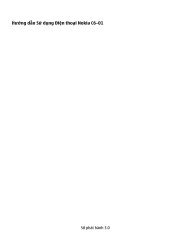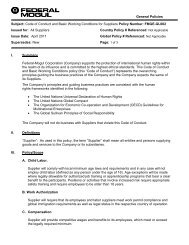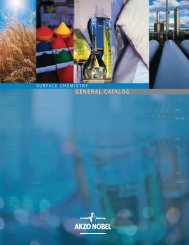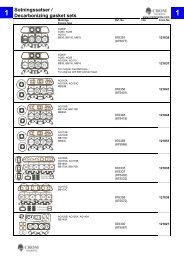You also want an ePaper? Increase the reach of your titles
YUMPU automatically turns print PDFs into web optimized ePapers that Google loves.
A<br />
ENGINEERING<br />
High Contact Angle (25˚) – Less Radial Rigidity<br />
Low Contact Angle (15˚) – More Radial Rigidity<br />
Increasing Radial Deflection<br />
B<br />
C<br />
D<br />
Increasing Radial Deflection<br />
B<br />
C<br />
D<br />
B Light Preload<br />
C Medium Preload<br />
D Heavy Preload<br />
Increasing Radial Load<br />
B Light Preload<br />
C Medium Preload<br />
D Heavy Preload<br />
Increasing Radial Load<br />
Fig. 18. Effect of contact angle on radial deflection.<br />
<strong>Timken</strong> ball screw support bearings are designed with a 60-degree<br />
contact angle. They are used <strong>for</strong> low-speed operations and offer the<br />
highest axial stiffness in the standard super precision ball bearing<br />
machine tool line. As contact angle increases, axial stiffness<br />
increases, radial stiffness decreases, and maximum operating<br />
speed decreases.<br />
<strong>Precision</strong> Class<br />
<strong>Super</strong> high precision MM/MMV bearings are manufactured with<br />
running accuracy and per<strong>for</strong>mance meeting ABEC 9/ISO P2 while<br />
maintaining other features at ABEC 7/ISO P4 levels <strong>for</strong> costeffectiveness.<br />
Ultraprecision MMX ABEC 9/ISO P2 have closer tolerances on<br />
bore and O.D. <strong>Bearings</strong> produced to these tolerances are used on<br />
ultra-high-speed grinding spindles designed <strong>for</strong> tight dimensional<br />
tolerances and superfine surface finishes.<br />
Hybrid Ceramic<br />
<strong>Timken</strong> has designed an advanced bearing that combines ceramic<br />
rolling elements with premium steel rings and state-of-the-art<br />
bearing technology to achieve maximum speed capability and<br />
greater stiffness. Compared with an all-steel bearing, the hybrid<br />
ceramic bearing's lower friction characteristics, even under<br />
marginal lubrication, result in less ball skidding, lower heat<br />
generation, higher speeds and greater overall system reliability.<br />
Ceramic balls are 60 percent lighter than steel with extremely fine<br />
surface finishes equal to or less than 0.5 micro-inch Ra. This helps to<br />
reduce centrifugal <strong>for</strong>ces and allows <strong>for</strong> a 20 percent higher speed<br />
factor than steel balls. Oil-lubricated ceramic hybrid bearings can<br />
operate up to three million dN, while grease-lubricated ceramic<br />
hybrids can run up to one million dN.<br />
dN = bore size (mm) x speed (RPM)<br />
The ceramic material has a modulus of elasticity 50 percent greater<br />
than steel, increasing bearing rigidity. This higher stiffness may<br />
result in higher contact stress levels in the bearings. Ceramics are<br />
generally not appropriate <strong>for</strong> higher loads and/or low speeds. As<br />
seen in Figure 19, below 750,000 dN, ceramic balls experience a<br />
reduction in overall rated bearing life.<br />
Theoretical Life (hours)<br />
1000000<br />
100000<br />
10000<br />
1000<br />
2MMVC99110WN CR<br />
50 mm bore<br />
750000 dN<br />
Steel balls<br />
0.0010 in. press fit<br />
100 lbs. spring preload<br />
Ceramic balls<br />
0 5 10 15 20 25 30 35 40 45 50<br />
Spindle (kRPM)<br />
Fig. 19. L 10 life vs. speed comparison of steel and ceramic balls.<br />
28 TIMKEN MACHINE TOOL CATALOG







